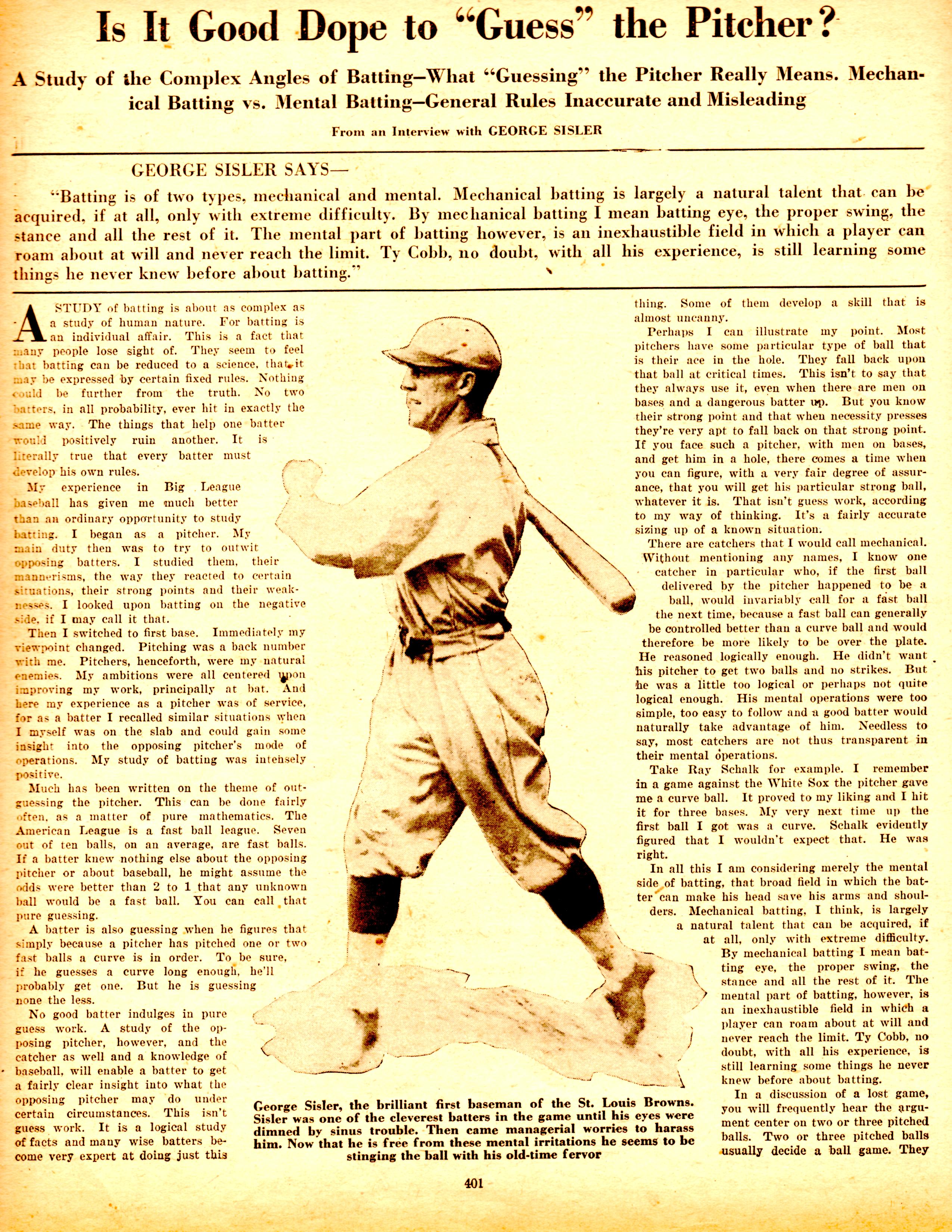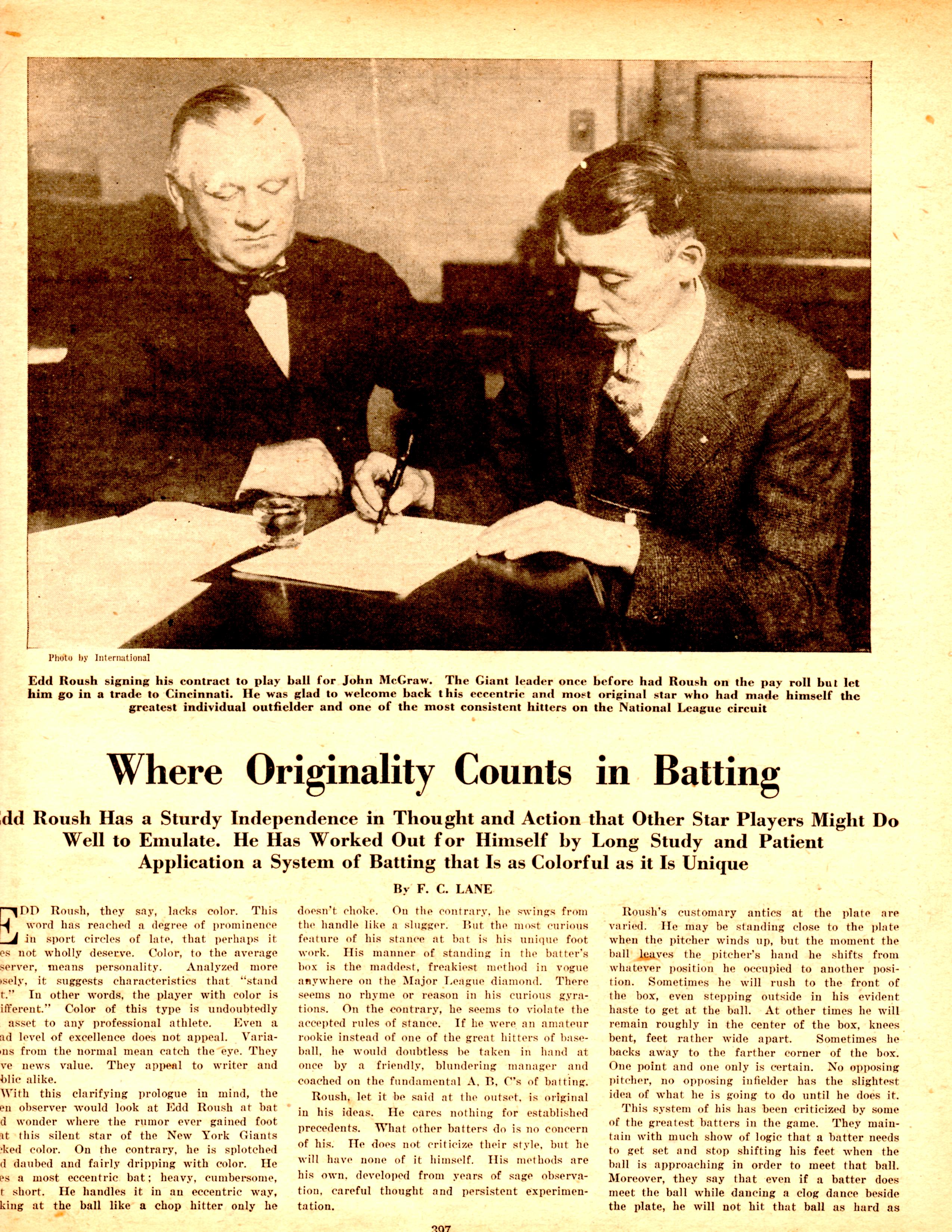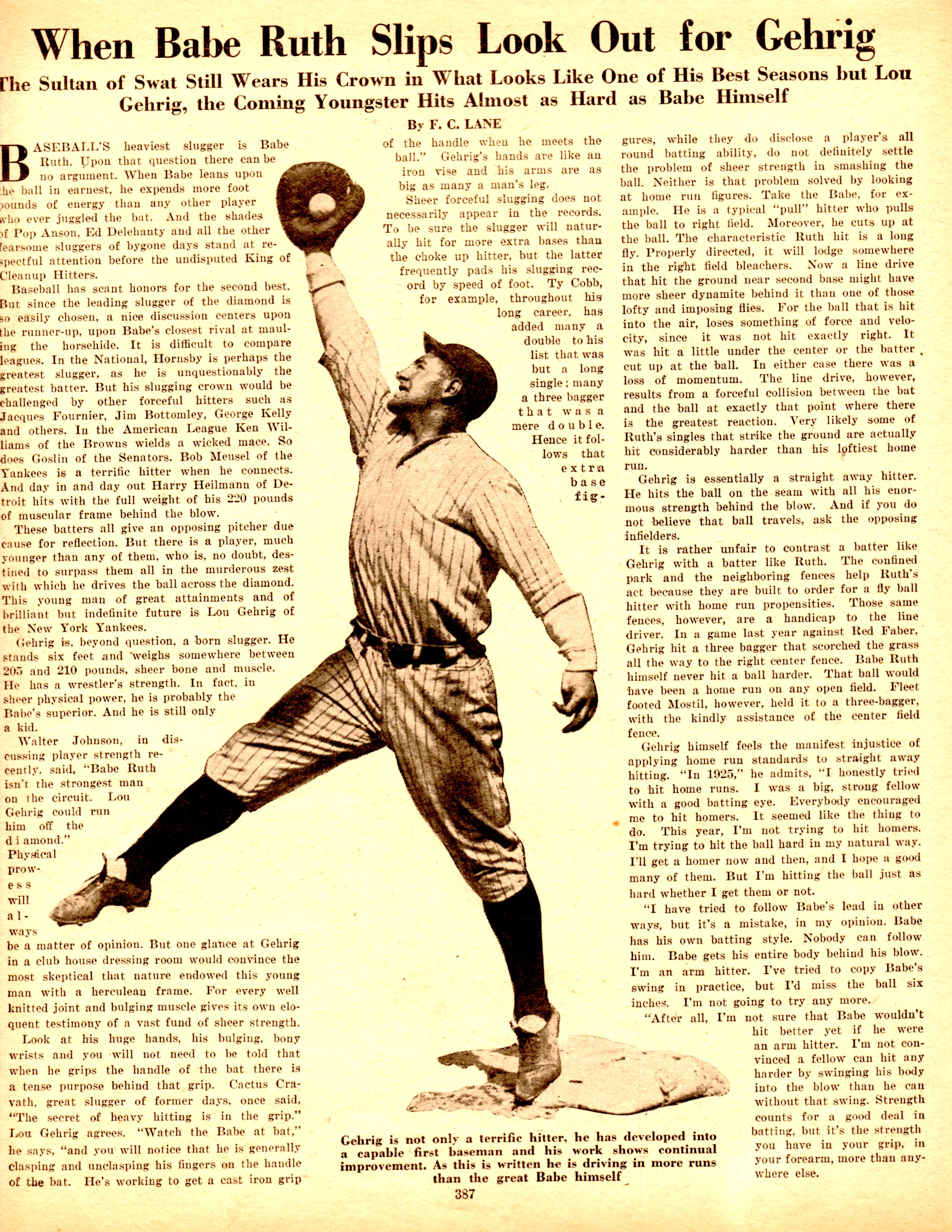How Lou Gehrig and other ballplayers from the 1920s used sabermetrics
Click here to access our MLB Tracker, which includes every offseason rumor, trade and signing.
To me, what sets Ferdinand Cole Lane — Henry Chadwick Award recipient and in my eyes the father of sabermetrics — apart from baseball writers, whether “traditional” or “sabermetric” or anything else (as if such distinctions mattered in the early 1900s), was his insatiable curiosity about the game. This curiosity led to his celebrated study of statistics, but it also manifested itself in many other ways in his Baseball Magazine, both in his articles and in what else was published under his editorial eye.
The best example I happen to have on hand comes from the August 1927 issue of the Magazine, in which Lane talks with Hall of Fame center fielder Edd Roush about his awkward batting mechanics. The issue also presents an interview with another Hall of Famer, George Sisler, and presents Lane’s disturbingly perfect prediction of Lou Gehrig (then just 24 years old and in his third full season) becoming the second-best hitter in baseball, followed by Babe Ruth.
Baseball Magazine’s interview with Sisler asks a question still relevant to today’s game: is it smart to guess what the pitcher is going to throw? Or, as Baseball Magazine puts it:

Sisler’s response is intriguing: he actually began his baseball career as a pitcher, and spent his rookie season in 1915 split between pitching (15 games, eight starts, 70 IP, 2.83 ERA, 101 ERA+) and batting (81 games, 295 PA, .285/.307/.369, 106 OPS+). He says of his pitching days, “I looked upon batting on the negative side, if I may call it that.”
Sisler addresses the purely mathematical side of guessing. “The American League is a fast ball league. Seven out of ten balls, on an average, are fast balls. If a batter knew nothing else about the opposing pitcher or about baseball, he might assume the odds were better than 2 to 1 that any unknown ball would be a fast ball. You can call that pure guessing.” But, as he continues, “No good batter indulges in pure guess work. A study of the opposing pitcher, however, and the catcher as well and a knowledge of baseball, will enable a batter to get a fairly clear insight into what the opposing pitcher may do under certain circumstances. This isn’t guess work. It is a logical study of facts.”
Sisler, then, is something of a sabermetrician — not so much with the spreadsheets and the basements, but Sisler is approaching the game from a logical, empirical way of thinking, and there is nothing more sabermetric than that.
Later in the interview, Sisler addresses the changes baseball was undergoing in the late 1920s, as Babe Ruth and the rest of Murderer’s Row were transforming the art of hitting and introducing the power stroke to a game where “place hitting” once rained supreme:
The whole trend of baseball in recent years has changed the underlying theory of batting. Short fences are now an irresistible magnet for many batters. They have proved so, to some extent, even in my own case. There is a strong inclination in almost any hitter to try to pull the ball toward a short fence. That inclination has ruined many batters.
I don’t place my hits anywhere nearly as frequently as I used to do. And I don’t hit as well as I used to do. I recognized years ago that batting conditions had altered and that a lot of weak hitters or indifferent hitters were beginning to appear in the .300 class, because of the lively ball and mere brute slugging. I didn’t throw overboard all that I had learned of place hitting and join the swim, but I temporized. I tried to do a little of both and my general work fell of in consequence.
It’s true: Sisler posted an OPS+ of at least 140 from age 24 through 29, culminating in an MVP award and a .420/.467/.594 season in 1922 for the Browns. In 1923, he suffered from acute sinusitis and vision problems resulting from the disease. His best season after the illness came in 1928 as a 35-year-old, when he hit .331/.370/.419 (111 OPS+) for Boston and Washington. Surely the changing game didn’t help, but one wonders if his vision wasn’t the bigger issue.
Few represent the changing nature of baseball around the end of the dead ball era better than Edd Roush. Roush posted at least a 124 OPS+ every year from 1917 through 1926 and was inducted into the Hall of Fame by the Veteran’s Committee in 1962. Roush’s batting style sounds like something from a wholly unrecognizable game.

Roush’s customary antics at the plate are varied. He may be standing close to the plate when the pitcher winds up, but the moment the ball leaves the pitcher’s hand he shifts from whatever position he occupied to another position. Sometimes he will rush to the front of the box, even stepping outside in his evident haste to get at the ball. At other times he will remain roughly in the center of the box, knees bent, feet rather wide apart. Sometimes he backs away to the farthest corner of the box. One point and one only is certain. No opposing pitcher, no opposing infielder has the slightest clue what he is going to do until he does it.
It’s difficult to imagine — the approach sounds almost Happy Gilmore-like, or like something a slow-pitch softball player might employ. It’s a great reason to lament the lack of video technology in the 1920s. Roush explains himself:
“Maybe my system wouldn’t work for them,” he says. “They’d be foolish to try it. But it works for me.”
“That’s the trouble with laying down rules,” continued Roush. “You figure that a fellow has a defect in hi style. Perhaps it might be a defect for you. It may be a strong point for him. There’s Jack Bentley. He’s a good hitter, but he hits on one leg, coming forward into the ball like a shot putter. I couldn’t hit that way, but he can. Babe Ruth has a swing that you could pick flaws in. He takes a big lunge at the ball and he cuts up at it. That would be a bad combination for some batters. It makes a home run slugger out of Ruth.”
Roush was the definition of a place hitter. He jumped around the box, he says, for two reasons: so infielders couldn’t predict where he would hit it — no shifts! — and so he wouldn’t get beaned by the pitch. These were the concerns of the place hitter, the first of which sounds alien in the power hitting world of baseball as is. Roush concludes:
The only difference between my stance and other batters’ stances is this. I’ve carried things to extremes. I’ve developed a peculiar type of position at the plate. But it’s just as foolish to criticize a batter’s individual taste in batting as it would be to blame him for wearing a soft felt hat instead of a brown derby.
Indubitably.
We conclude with Gehrig. The first article in the issue of Baseball Magazine at hand issues perhaps the strongest prediction in sportswriting history:

“…the Coming Youngster Hits Almost as Hard as Babe Himself.” Gehrig went on to win the MVP in 1927, if only because Ruth was ineligible due to his 1923 victory. Ruth hit .356/.476/.772, the latter two league-leading figures, and set the home run record with 60 to go with a 225 OPS+. He was, at 32 years old, obviously the best hitter in the game.
But Gehrig was already not far behind. It was August of 1927 when Lane published his article, so who knew he would go on to rival Ruth’s numbers. Gehrig hit .373/.474/.765 with 47 home runs of his own and a 220 OPS+. Gehrig discusses his hitting style with Lane:
In 1925, I honestly tried to hit home runs (he hit 20 in 126 games en route to a .295/.365/.531 line as a 25-year-old). “I was a big, strong fellow with a good batting eye. Everybody encouraged me to hit homers. It seemed like the thing to do. This year, I’m not trying to hit homers. I’m trying to hit the ball hard in my natural way. I’ll get a homer now and thhen, and I hope a good many of them. But I’m hitting the ball just as hard whether I get them or not.
Of course, Gehrig did get “a good many” home runs, and he would lead the league in the category thrice over the course of his career (1931, 46; 1934, 49; 1936, 49 again). But, as Gehrig says, and following the theme of what all three hitters have said, he has had to refine his individual approach and refrain from copying others.
“I have tried to follow Babe’s lead in other ways, but it’s a mistake, in my opinion. Babe has his own batting style. nobody can follow him. Babe gets his entire body behind his blow. I’m an arm hitter. I’ve tried to copy Babe’s swing in practice, but I’d miss the ball six inches. I’m not going to try any more.”
“After all, I’m not sure that Babe wouldn’t hit better yet if he were an arm hitter. I’m not convinced a fellow can hit any harder by swinging his body into the blow than he can without that swing. Strength counts for a good deal in batting, but it’s the strength you have in your grip, in your forearm, more than anywhere else.”
Gehrig was proven wrong here by the course of history. Any good hitting instructor knows power comes more from the hips and the core than the arms, and Ruth’s swing is one of the few from the era that is even recognizable at this point in time.
Still, Gehrig was a baseball thinker, and many of the conclusions he came to have been borne out in the nearly eight decades since the interview.
I believe they ought to keep a record of a batter’s line drives. They don’t do that, of course. They merely keep a record of the number of balls he hits that go safe.
There are a lot of fluky little hits that the batter got crossed up on, really failed, and yet beat out. In one series last year, I had eleven hard drives caught by infielders or outfielders, solid smashes that ought to have been good for hits.
Batting averages, as I understand them, are supposed to give an insight into a batter’s ability. I’m not saying that if a man is clever enough to lay down a bunt and fast enough to beat it out that he’s not entitled to a hit. But there are a lot of flukey little things that are just luck. A batter isn’t entitled to them, but he is entitled to good, honest drives that don’t get through. He’s hitting the ball and everybody knows it, no matter what the averages say.
This way of thinking, again, is as much sabermetric thought as any result borne from hours pored over spreadsheets or the Baseball-Reference play index. It’s fascinating to see how so many things — like Gehrig’s entirely correct assessment of batting average and Roush’s realization that mental comfort at the plate can be as important as proper mechanics — have remained the same, even as the circumstances surrounding the game have changed so much.
Lane’s unyielding pursuit of baseball knowledge, whether through inventing new statistics or discussing the processes players go through on the field, added a vast wealth for any baseball fan, whether in the late 1920s or here in the early 2010s. It should be a model for those who wish to pursue baseball knowledge today. This knowledge comes from a vast variety of sources, and those with even a fraction of his curiosity should consider Lane and his magazine a model for how to apply it.